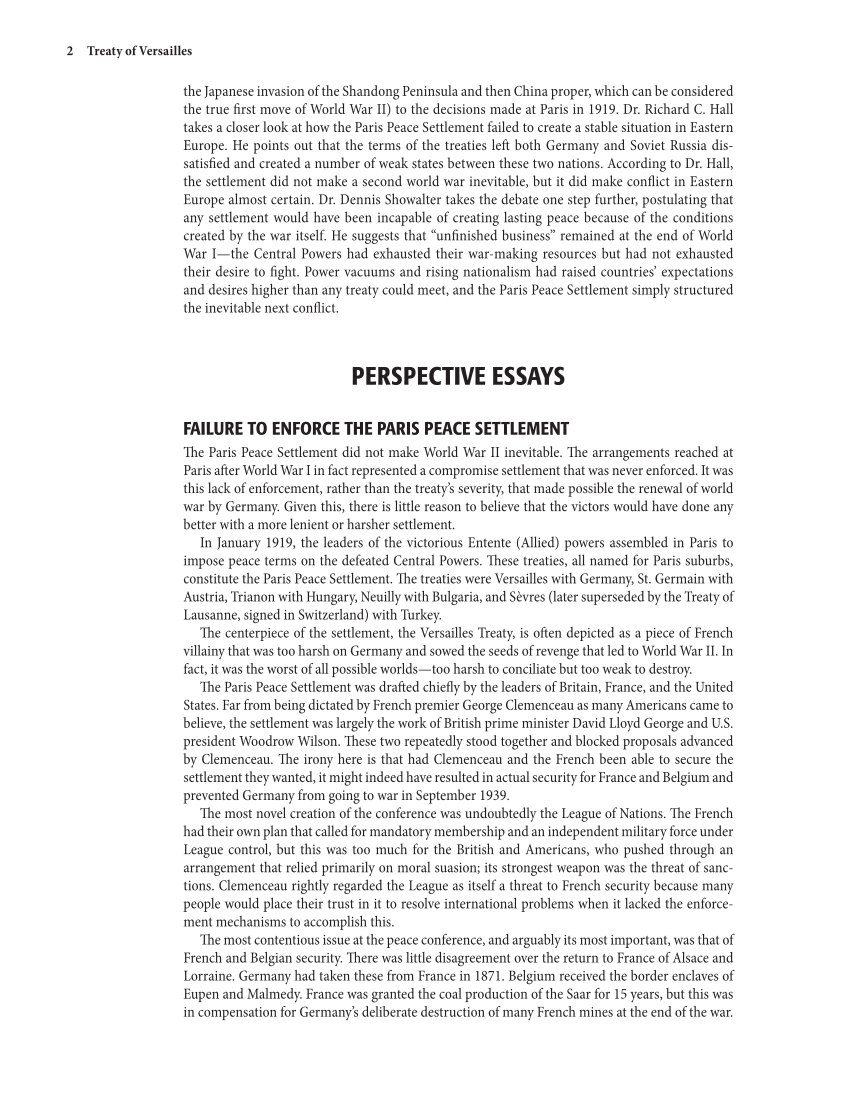2 Treaty of Versailles the Japanese invasion of the Shandong Peninsula and then China proper, which can be considered the true first move of World War II) to the decisions made at Paris in 1919. Dr. Richard C. Hall takes a closer look at how the Paris Peace Settlement failed to create a stable situation in Eastern Europe. He points out that the terms of the treaties left both Germany and Soviet Russia dis- satisfied and created a number of weak states between these two nations. According to Dr. Hall, the settlement did not make a second world war inevitable, but it did make conflict in Eastern Europe almost certain. Dr. Dennis Showalter takes the debate one step further, postulating that any settlement would have been incapable of creating lasting peace because of the conditions created by the war itself. He suggests that “unfinished business” remained at the end of World War I—the Central Powers had exhausted their war-making resources but had not exhausted their desire to fight. Power vacuums and rising nationalism had raised countries’ expectations and desires higher than any treaty could meet, and the Paris Peace Settlement simply structured the inevitable next conflict. PERSPECTIVE ESSAYS FAILURE TO ENFORCE THE PARIS PEACE SETTLEMENT The Paris Peace Settlement did not make World War II inevitable. The arrangements reached at Paris after World War I in fact represented a compromise settlement that was never enforced. It was this lack of enforcement, rather than the treaty’s severity, that made possible the renewal of world war by Germany. Given this, there is little reason to believe that the victors would have done any better with a more lenient or harsher settlement. In January 1919, the leaders of the victorious Entente (Allied) powers assembled in Paris to impose peace terms on the defeated Central Powers. These treaties, all named for Paris suburbs, constitute the Paris Peace Settlement. The treaties were Versailles with Germany, St. Germain with Austria, Trianon with Hungary, Neuilly with Bulgaria, and Sèvres (later superseded by the Treaty of Lausanne, signed in Switzerland) with Turkey. The centerpiece of the settlement, the Versailles Treaty, is often depicted as a piece of French villainy that was too harsh on Germany and sowed the seeds of revenge that led to World War II. In fact, it was the worst of all possible worlds—too harsh to conciliate but too weak to destroy. The Paris Peace Settlement was drafted chiefly by the leaders of Britain, France, and the United States. Far from being dictated by French premier George Clemenceau as many Americans came to believe, the settlement was largely the work of British prime minister David Lloyd George and U.S. president Woodrow Wilson. These two repeatedly stood together and blocked proposals advanced by Clemenceau. The irony here is that had Clemenceau and the French been able to secure the settlement they wanted, it might indeed have resulted in actual security for France and Belgium and prevented Germany from going to war in September 1939. The most novel creation of the conference was undoubtedly the League of Nations. The French had their own plan that called for mandatory membership and an independent military force under League control, but this was too much for the British and Americans, who pushed through an arrangement that relied primarily on moral suasion its strongest weapon was the threat of sanc- tions. Clemenceau rightly regarded the League as itself a threat to French security because many people would place their trust in it to resolve international problems when it lacked the enforce- ment mechanisms to accomplish this. The most contentious issue at the peace conference, and arguably its most important, was that of French and Belgian security. There was little disagreement over the return to France of Alsace and Lorraine. Germany had taken these from France in 1871. Belgium received the border enclaves of Eupen and Malmedy. France was granted the coal production of the Saar for 15 years, but this was in compensation for Germany’s deliberate destruction of many French mines at the end of the war.
Document Details My Account Print multiple pages
Print
You have printed 0 times in the last 24 hours.
Your print count will reset on at .
You may print 0 more time(s) before then.
You may print a maximum of 0 pages at a time.





















































































































































































































































































































